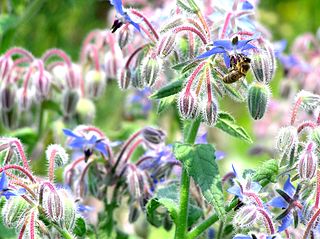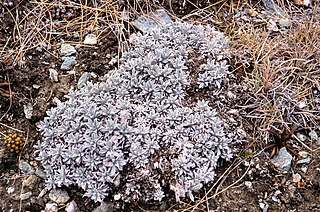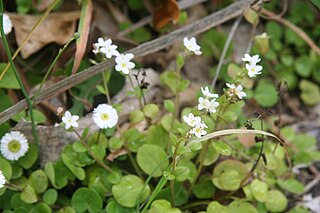
Boraginaceae, the borage or forget-me-notfamily, includes about 2,000 species of shrubs, trees, and herbs in 146 to 156 genera with a worldwide distribution.

Pulmonaria (lungwort) is a genus of flowering plants in the family Boraginaceae, native to Europe and western Asia, with one species east to central Asia. According to various estimates there may be between 10 and 18 species found in the wild.

Lithospermum is a genus of plants belonging to the family Boraginaceae. The genus is distributed nearly worldwide, but most are native to the Americas and the center of diversity is in the southwestern United States and Mexico. Species are known generally as gromwells or stoneseeds.

Boraginales is an order of flowering plants in the asterid clade. It includes the Boraginaceae and a number of other families, with a total of about 125 genera and 2,700 species. Its herbs, shrubs, trees and lianas (vines) have a worldwide distribution.

Lithospermum arvense, known as field gromwell, corn gromwell, bastard alkanet, and stone seed, is a flowering plant of the family Boraginaceae. It is native to Europe and Asia, as far north as Korea, Japan and Russia, and as far south as Afghanistan and northern Pakistan. [1] It is known in other places as an introduced species, including much of North America and Australia. [2],[3] The European Union has granted the refined oil of the seed of Buglossoides arvensis novel food status and some farmers are growing it [4] commercially in the United Kingdom as a plant-variety patented (PVP) and trademarked cultivar (Ahiflower®). The seed oil contains high levels (63-72%) of omega-3 ALA (c18:3), omega-3 SDA (c18:4), and omega-6 GLA (c18:3)[5] and has GRAS review status from the US Food and Drug Administration, Canadian ingredient master file (IMF) registration and novel food status, and GMP+ Feed Support Product status in the EU for livestock and companion animals. The seed oil also has TGA Australia Complementary Medicines approval status, ANVISA/MAPA Brazil human and animal alimentary use approval, and limited food use approvals in Korea and Japan.
Hoplestigma is a genus of flowering plants in the family Boraginaceae, although this is disputed, and it has been placed in its own family Hoplestigmataceae. Its two species are native to Cameroon, Gabon, Ivory Coast and Liberia in western tropical Africa.

Boraginoideae is a subfamily of the plant family Boraginaceae s.s, with about 42 genera. That family is defined in a much broader sense in the Angiosperm Phylogeny Group (APG) system of classification for flowering plants. The APG has not specified any subfamilial structure within Boraginaceae s.l.

Buglossoides is a genus consisting of 15 species of annual or perennial herbs, native to Europe and Asia. They grow naturally in habitats ranging from sunny scrub to rocky slopes and woodland areas. These plants are covered in fine bristles or hairs. The stems are upright or sprawling, branched or unbranched, with simple oval to lance-shaped leaves. The small funnel-shaped flowers have flaring lobes and are usually blue or white. Perennial species that are rhizomatous can become invasive and difficult where conditions are suitable.

Phacelia stellaris is a rare species of flowering plant in the borage family, Boraginaceae, known by the common names star phacelia and Brand's phacelia.

Lithospermum purpurocaeruleum is a synonym for Aegonychon purpurocaeruleum (L.) Holub, also known as the purple gromwell, This plant is a herbaceous perennial rhizomatous flowering plant and it belongs to the family Boraginaceae.

Myosotis pansasubsp. pansa, also known as the Waitakere forget-me-not, is a subspecies of flowering plant in the family Boraginaceae, endemic to the North Island of New Zealand. Lucy Moore described the variety M. petiolata var. pansa in 1961, and it was transferred to a subspecies of M. pansa by Heidi Meudt, Jessica Prebble, Rebecca Stanley and Michael Thorsen in 2013. Plants of this species of forget-me-not are perennial rosettes with ebracteate inflorescences and white corollas with exserted stamens.

Myosotis capitata is a species of flowering plant in the family Boraginaceae, endemic to the Campbell and Auckland Islands of New Zealand. Joseph Dalton Hooker described the species in his 19th century work Flora Antarctica. Plants of this species of forget-me-not are perennial and erect, and have ebracteate inflorescences and blue corollas. It is one of two native species of Myosotis in the New Zealand subantarctic islands, the other being M. antarctica, which can also have blue corollas.

Dasynotus is a monotypic genus of flowering plants belonging to the family Boraginaceae, it only contains one known species, Dasynotus daubenmireiI.M.Johnst..

Myosotis secunda, also known as the creeping forget-me-not is a species of flowering plant from the family Boraginaceae.
Myosotis umbrosa is a species of flowering plant in the family Boraginaceae, endemic to the South Island of New Zealand. Heidi Meudt, Jessica Prebble and Michael Thorsen described the species. Plants of this species of forget-me-not are perennial with a prostrate habit, bracteate inflorescences, and white corollas.

Myosotis albiflora is a species of flowering plant in the family Boraginaceae, native to southern Chile and Argentina. This species was described by Joseph Banks and Daniel Solander in Joseph Dalton Hooker's 19th century work Flora Antarctica. Plants of this species of forget-me-not are perennial and have white corollas. It is one of two native species of Myosotis in southern South America, the other being M. antarctica.

Myosotis albosericea is a species of flowering plant in the family Boraginaceae, endemic to the South Island of New Zealand. Joseph Dalton Hooker described the species in 1867. Plants of this species of forget-me-not are perennial rosettes which form loose clumps, with ebracteate, erect inflorescences, and yellow corollas.

Myosotis pansa is a species of flowering plant in the family Boraginaceae, endemic to the North Island of New Zealand. Lucy Moore described the variety M. petiolata var. pansa in 1961, and it was raised to species level as M. pansa by Heidi Meudt, Jessica Prebble, Rebecca Stanley and Michael Thorsen in 2013. Plants of this species of forget-me-not are perennial rosettes with ebracteate inflorescences and white corollas and exserted anthers.

Myosotis pansa subsp. praeceps is a subspecies of flowering plant in the family Boraginaceae, endemic to the North Island of New Zealand. Lucy Moore described the variety M. petiolata var. pansa in 1961, and it was transferred to a subspecies of M. pansa by Heidi Meudt, Jessica Prebble, Rebecca Stanley and Michael Thorsen in 2013. Plants of this species of forget-me-not are perennial rosettes with partially bracteate inflorescences and white corollas with exserted stamens.
















